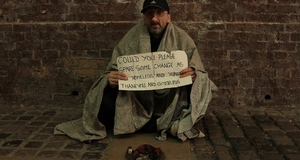Featured Article:Minorities and Homelessness in the United States and Europe: A Comparative AnalysisResults from Interviews with Social WorkersResponses of social workers working directly with the homeless provide an added perspective in exploring the research question, however, it must be noted that their answers can be biased by their own background and experience. Their answers are used to highlight certain trends, and cannot prove or disprove the study hypotheses. In addition, the ways in which the social worker thinks about the world also informs his or her practice. With regards to trends and issues commonly encountered, the three social workers mentioned substance abuse, mental illness, criminal background for males, physical disabilities, lack of income, the high cost of living in D.C., and lack of family support. Social worker #1, who works with homeless men at 801 East Men’s Shelter in Washington, stated that although official D.C. statistics show a rate of substance abuse among the homeless as 15%, these are self-reported, and the actual rate is more along the lines of 70%. Also, he stated that the prevalence of mental illness is approximately 50% (interview with social worker #1, May 16, 2012).3 Social worker #2, also from 801 East, pointed out that there is a nexus between drugs, mental health, and homelessness. Drugs can lead to the mental health problems. Furthermore, those discharged from mental institutions are discharged into the streets (interview with social worker #2, May 16, 2012). Social worker #3, who works with homeless women at Nativity Women’s Shelter in Washington, and who has worked with homeless men in the past, also stated that the mental illness precedes homelessness; usually, the illness manifests later in life. Even though most often treatment precedes homelessness as well, individuals end up in shelters because of a lack of continued family support; the most common mental illnesses she has encountered are bipolar and schizophrenia; there are also personality disorders and depression (interview with social worker #3, June 28, 2012). While the social workers expressed that there is a link between drug abuse, mental illness, and criminal background leading to homelessness, which would appear to be individual-level causes of homelessness, institutional racism, biases, and historical disadvantages of minorities quickly came up during the interviews. Two of the social workers indicated that there are systemic factors and racial biases at play when it comes to mental health and developmental disability diagnoses, which have implications later in life, holding people back. Many African Americans are hesitant to take pills because of instances whereby doctors in the past misdiagnosed mental issues more severely for African Americans, and these mistakes came to light with severe consequences (interview with social worker #3, June 28, 2012). It has also been found that there is a tendency to diagnose African American children more severely with ADHD rather than ADD. Although a more severe diagnosis results in more government financial support, it’s also more debilitating for opportunities later in life (interview with social worker #1, May 16, 2012).With regards to the question of minority overrepresentation, when asked why then do these drivers of homelessness affect minorities more than Caucasians, and why minorities are overrepresented in the homeless population, the social workers gave slightly different answers: one expressed the problem along the lines of unintentional discrimination and durable inequality (social worker #1), one believed it is a reflection of African American culture and lifestyle (social worker #2), and the other stated that it is an example of the intentional effort to subjugate minorities in different ways throughout history (social worker #3). There was no agreement as to whether there is a difference in the process of homelessness among different racial/ethnic groups, but there was an agreement that there is no evidence of direct discrimination leading to homelessness in clients’ profiles. Social worker #2 stated that culture and environment informs how people live their lives, and African Americans are more likely to be raised in a culture of teen pregnancy and drugs leading to criminal activity; he expressed that many of the clients started using drugs as young as 12 years old as a learned habit from family. He stated that he has not come across many Caucasian clients, but from the 3 that he has interacted with since 2010, the reason they became homeless was the same as that of the African American clients; he was hesitant to state that there is a racial/ethnic difference in the experience of homelessness. He stated that immigrants who are homeless have the same problems of involvement with drugs and crime, the only difference being that undocumented clients do not have access to any benefits except staying in overnight shelters that do not require ID checks; he stated that most of the homeless immigrants he works with are actually documented (interview with social worker #2, May 16, 2012). By contrast, social worker #3 stated that the issues that undocumented clients have are not necessarily the same; they are in a different type of crisis such as running from war, and have trouble trusting and opening up to social workers; the only benefits undocumented homeless receive is medical assistance and stay in overnight shelters. In terms of racial/ethnic differences in experience, social worker # 3 was also of the opinion that Caucasian and African American clients both have mental illnesses coupled with lack of family support, and stresses of everyday life. She did state that there are gender differences, whereby women are much less likely to have a criminal background and more likely to have finished at least high school, while men are more likely to have dropped out (interview with social worker #3, June 28, 2012). Similar to social worker #2, she pointed to social environment to explain minority overrepresentation among the homeless. She stated that there are simply more blacks, specifically black males, growing up in crisis situations whereby they are living in poverty and drug abundant neighborhoods. Family support for those who fall into homelessness is not there due to the single parent home phenomenon as well as the fact that parents themselves may have fallen victims to drugs. By contrast to social worker #3, she emphasized a genuine effort to keep African Americans down, also highlighting the overrepresentation of African American males in prisons who are then released into the streets. She believes that there is “a systematic effort to destroy blacks and the black family going back to slavery” (interview with social worker #3, June 28, 2012). Social worker #1 provided similar answers to explain minority overrepresentation, bringing attention to the lack of family support due to the breakdown of the family, poverty, and drugs in African-American communities. More specifically, he said the reason why whites who fall into drug and alcohol addiction are not as much seen among the homeless population is because they have the family support. He also added that most of the (African American) clients encountered come from areas with bad educational systems and hence are high school drop outs, setting them onto a disadvantaged path; social worker #1 also pointed to the overrepresentation of African American males in prisons due to the drugs sentencing disparities of the 1980s and 1990s, and related this to homelessness because it put so many into joblessness and a downward spiral (interview with social worker #1, May 16, 2012). With regards to whether African American clients experience direct discrimination that could have been a cause of their homelessness, social worker #1 mentioned the effect of the criminal background for males. He stated that the impact of the background depended on the nature of the crime; for example, those with sex offenses have the most difficult time because they are banned from public housing, and sometimes not even social workers want to provide assistance. Those with drug convictions and other felonies also have difficulties when it comes to finding employment. Overall, social worker #1 concluded that the overrepresentation of minorities among the homeless is not due to direct discrimination or an intentional effort by some to subjugate others, but an institutional racism dating back to slavery, and permeating into everyday experiences of many African Americans (interview with social worker #1, May 16, 2012). With regards to whether people who are homeless want to work and are seeking employment, the social workers pointed to the fact that many work either part time or full time, but there are inhibitors such as the low skill levels mentioned previously, disabilities, and the shelter system itself. Social worker #3 highlighted that some of the female clients she’s worked with have college degrees but are held back by a mental illness (interview with social worker #3, June 28, 2012). Social worker #1 that the disabilities encountered among clients are primary physical, requiring heavy medication leading people to become “sleepwalkers..who are not able to function” (interview with social worker #1, May 16, 2012). Social worker #1 stated that emergency shelters, which only allow people to stay overnights, are not set up in a way that enables people to look for employment because clients have to carry their items with them throughout the day. In addition, while there are homeless empowerment programs that provide technical skills and assistance with getting a job, there are very limited resources available (interview with social worker #1, May 16, 2012). Results from Interviews with People that are HomelessThis section discusses how the interview results compare with the hypotheses developed. Given that the names of the interviewees will remain anonymous, they will be referred to as participants and have been given a number; the sequence of the numbers does not reflect the sequence in which participants were interviewed. Below is a demographic snapshot of the forty-four participants interviewed for this study. The average age for women was 50 and that for men was 52. While race and immigration status are not comparable categories, for example a person can be a Caucasian immigrant, there is no overlap or double count represented in the below charts. For the purposes of this study, all African American and Caucasians were born in the United States, and all Caucasian immigrants were counted in the immigrant category. The demographic profile of the study participants was not preselected; most participants are African American due to their overrepresentation in the shelters, as previously discussed. Figure 5. Demographic snapshot of study participants
Figure 6. Study participants by gender
Table 4. Percentages of participants that possess mental illnesses, physical disabilities, and alcohol and/or drug addiction issues.
This section tests hypothesis #2, that all people that are homeless possess vulnerabilities interfering with their ability to gain stable living such as: mental illness, drug and alcohol addictions, physical disabilities, and domestic violence histories most notably in women. The table above is a snapshot giving insight into the percentages of people interviewed that possess these individual level factors discussed in the literature review. This section provides examples and describes stories of people whose mental illnesses, addiction issues or physical disabilities seemed to have played a central role in their homelessness. Results show that these issues do not play a central role in all people. The totals represent numbers of people who have each of these issues out of the total number of participants, and the percentages in each categorically defined row (African American, etc.) represent the numbers of people who have those issues out of the total numbers of people in each particular category (row).Continued on Next Page » Suggested Reading from Inquiries Journal
Inquiries Journal provides undergraduate and graduate students around the world a platform for the wide dissemination of academic work over a range of core disciplines. Representing the work of students from hundreds of institutions around the globe, Inquiries Journal's large database of academic articles is completely free. Learn more | Blog | Submit Latest in Sociology |




















